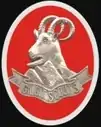Gilgit Scouts
The Gilgit Scouts constituted a paramilitary force of the Gilgit Agency in the northern Jammu and Kashmir. They were raised by the British Raj in 1913, on behalf of the princely state of Jammu and Kashmir, to police the northern frontier of India.

In November 1947, under the command of Major W. A. Brown, the Gilgit Scouts overthrew the Governor of Jammu and Kashmir state in Gilgit, and declared accession to Pakistan. The Muslim element of the State Forces joined the rebels and neutralised the non-Muslim troops. Colonel Aslam Khan was given the command of the force by the Azad Kashmir provisional government. The combined force conquered Skardu (the capital of Baltistan) and threatened Ladakh, leading to the eventual formation of Gilgit-Baltistan which continues to be under Pakistani control.
The force of Gilgit Scouts was continued by Pakistan till 1975 when it was integrated into the Northern Light Infantry of the Pakistan Army.
History
Antecedents
The Gilgit Agency was originally defended by the Imperial Service Troops provided by the Maharaja of Jammu and Kashmir and placed under the command of the Agency.[1][2] A few contingents of British Indian troops and 14 British officers were added in 1891.[3] After the pacification of Hunza, Nagar, Chilas and Chitral, these troops were gradually reduced, and replaced by local levies from Hunza, Nagar and Punial.[4] The levies from Punial were present even earlier, and participated in the Hunza–Nagar Campaign in 1891.[5]
Formation
In 1913, the local levies were replaced by a permanent body of troops on a company basis, under the name "Gilgit Scouts". The force was paid for by the state of Jammu and Kashmir, but commanded by British officers under the control of the British Political Agent at Gilgit.[6] The initial strength of Gilgit Scouts was 656 men, organised into 8 companies of 80 men each. Each company had two native officers, a Subedar and a Jamadar.[6]
The force had no connection to the Jammu and Kashmir State Forces,[7] but became part of the Frontier Corps, along with Chitral Scouts, Kurram Militia and other local forces.[8] The recruits were from all areas of the Gilgit Agency and had the advantage of local knowledge. They were also acclimatised to local climate in the harsh mountain terrain. They were responsible for maintaining local order as well as monitoring the foreign activity along the northern borders.[7]
The recruitment in the Gilgit scouts was based on the recommendation of Mirs and Rajas of the area. Close relatives of Mirs and Rajas were given direct Viceroy commissions in Gilgit scouts.
First Kashmir War
After the Partition of India, the Gilgit Scouts joined with the forces of the Pakistan Army in attacks against forces of the erstwhile princely state during the First Kashmir War. According to British Major William Brown, one-time commanding officer, there was a secret plan among few members of Gilgit Scouts to set up a "Republic of Gilgit-Astor(e)" when they ousted the armed forces of the Maharajah of Kashmir on November 1, 1947. Dani mentions that although there was lack of public participation in the rebellion, pro-Pakistan sentiments were intense in the civilian population and their anti-Kashmiri sentiments were also clear.[9] Thus on November 2, the Pakistani flag was raised on the old tower in the Gilgit Scout Lines, under the command Major Brown.[10]
On 12 January 1948, the command was handed over to Colonel Aslam Khan the First Muslim Commander of the Gilgit Scouts.[10]
Inside Pakistan
After conclusion of the war, the Gilgit Scouts operated as a paramilitary force in the Northern Areas, until 1975, when it became amalgamated into the Northern Light Infantry Regiment where the Gilgit Scouts became the 1st and 2nd Battalions Northern Light Infantry.[11]
Gilgit Baltistan Scouts
The force was re-raised in 2003 as the Northern Area Scouts under command of Brigadier Inayat Wali. It quickly progressed and took over the responsibilities of Law and Order in Gilgit Baltistan. January 18, 2011, The Interior Ministry renamed the Northern Areas Scouts as Gilgit Baltistan Scouts, in view of the reforms introduced in the region.[12]
References
- Schofield, Kashmir in Conflict 2003, p. 13; Snedden, Understanding Kashmir and Kashmiris 2015, p. 109
- Chohan, Gilgit Agency 1997, p. 180.
- Chohan, Gilgit Agency 1997, p. 183.
- Chohan, Gilgit Agency 1997, pp. 189–190.
- Huttenback, Robert A. (2008). "The 'Great Game' in the Pamirs and the Hindu-Kush: The British Conquest of Hunza and Nagar". Modern Asian Studies. 9 (01): 1–29. doi:10.1017/S0026749X00004856. ISSN 0026-749X.
- Chohan, Gilgit Agency 1997, p. 192.
- Snedden, Understanding Kashmir and Kashmiris 2015, p. 109.
- Bajwa, Kuldip Singh (1 January 2004). Jammu and Kashmir War: 1947 & 1948. India: Har Anand Publications. p. 140. ISBN 978-81-241-0923-6. Retrieved 2009-08-31.
- Bangash, Three Forgotten Accesions 2010, p. 132.
- Schofield, Kashmir in Conflict 2003, p. 64.
- "Northern Light Infantry". Globalsecurity.org. Archived from the original on 4 March 2016.
- Gilgit Baltistan Scouts (official web page)
Bibliography
- Bangash, Yaqoob Khan (2010), "Three Forgotten Accessions: Gilgit, Hunza and Nagar", The Journal of Imperial and Commonwealth History, 38 (1): 117–143, doi:10.1080/03086530903538269
- Chohan, Amar Singh (1997), Gilgit Agency 1877-1935, Second Reprint, Atlantic Publishers & Dist, ISBN 978-81-7156-146-9
- Schofield, Victoria (2003) [First published in 2000], Kashmir in Conflict, London and New York: I. B. Taurus & Co, ISBN 1860648983
- Snedden, Christopher (2015), Understanding Kashmir and Kashmiris, Oxford University Press, ISBN 978-1-84904-342-7
